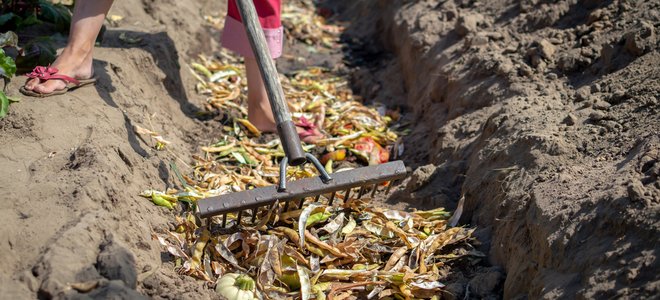 2 hours • Beginner • 0-20 What You’ll Need Kitchen scraps Garden scraps Shovel What You’ll Need Kitchen scraps Garden scraps Shovel
2 hours • Beginner • 0-20 What You’ll Need Kitchen scraps Garden scraps Shovel What You’ll Need Kitchen scraps Garden scraps Shovel
Want to compost but don’t have time to put in the work to get a great compost? Say goodbye to the old way of composting and say hello to trench composting. Trench composting is a fast, easy way to compost that doesn’t require any turning.
What is Trench Composting
Trench composting is a compost creation method where you combine kitchen and garden waste that requires very little work. To trench compost in your own yard, you will, as the name implies, need to dig a trench. Make the trench at least a foot deep. Then you will fill the hole with roughly six inches of compostables and then burry those materials in the trench. A few smell-free, work-free months later, you’ll have top-notch compost ready in your garden.
Because of the proximity, your plants will have to the trench, you don’t really need to do anything else. Your plant roots will benefit from the compost simply by being near it. You don’t want to plant your garden right on top of the trench, but there are a few methods that work for planting your garden near the trench.

The Nitty Gritty
One way of trench composting starts with dividing your garden into groups of three rows, or just three areas. The first area is the trench, the second area is the walkway, and the third area is the planting zone. The benefit of this method comes with the rotation of the zones. Every year, each zone shifts one and so the old compost trench becomes the planting zone, the walkway becomes the new compost trench, and the old garden becomes the walkway. It’s an easy rotation system that keeps your soil in great condition year after year after year. Once you get back to the beginning, simply start your rotation all over again. You’ll be growing strong, healthy plants year after year.
Another way to use compost trenches is by simply adding a trench or two between rows of plants. If your garden is evenly spaced rows, simply add a long, thin compost zone between the two rows.
The last way to use trench composting is less trench and more holes. You can dig foot-deep holes around your garden and fill those holes with compost. Put these holes in close proximity to your growing plants. The easy thing about this method is that it takes very little time and it can be done in any spot that needs a little extra compost love. Your holes and compost trenches don’t need to be a certain size so as long as the holes are deep enough, you can simply place them exactly where you need them.

Why Trench Compost?
Trench composting is fast and easy. In some areas, you’re not allowed to have a traditional compost box because of HOA restrictions or local legislation. Trench composting literally digs its way around rules like that because it works in a completely different way. There aren’t any foul odors associated with trench composting and because that’s a huge drawback of traditional composting, you may be able to trench compost in an area where other forms are not allowed.
Trench composting also benefits your garden for years to come. When you improve your soil quality, you improve your growth potential not just one year, but the next several years as well. If you are a serious gardener (or an amateur intimidated by normal composting methods) start here. You’ll be surprised by just how much your garden improves in a few short months.
Another big plus for trench composting is that it delivers the nutrients to where your plants actually need it, the root system. When you nourish the roots of your plants, you get better, healthier plants. Placing compost on the top of the soil just isn’t as effective.
Prep for your new compost trench by collecting kitchen scraps and garden scraps that are great for any kind of composting. Make sure to avoid anything that won’t compost well or that will harm the soil.
Source link : https://www.doityourself.com/stry/no-work-gardening-with-trench-composting












